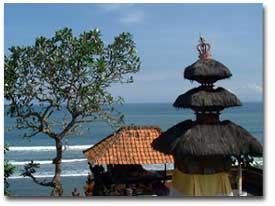| Government
and Districts
Bali
is one of the 26 provinces of Indonesia. Within Bali there
are eight kabupatens or districts, which under the Dutch were
known as regencies. These are Badung,
Gianyar, Bangli,
Klungkung, Karangasem,
Buleleng, Jembrana,
Tabanan. There
are now nine districts since the addition of Kotamadya
Denpasar.
Each district is headed by a government official known as
a bupati. The districts are further subdivided into subdistricts
called Kecamatan which is headed by a camat, then come the
perbekels, the head of a desa (village) and finally, an enormous
number of banjars, the local divisions of a village.
Jembrana
Regency
 Jembrana
is perhaps the most ethnically heterogeneous regency in Bali.
The Loloan area is populated by a malay-speaking populace
of Bugis descent. There are also many Balinese Christians,
because part of Jembrana was converted to Catholicism and
Protestantism at the start of the century. Also there are
plenty of traditional Balinese communities, particularly in
the rice-growing areas of the regency. Jembrana
is perhaps the most ethnically heterogeneous regency in Bali.
The Loloan area is populated by a malay-speaking populace
of Bugis descent. There are also many Balinese Christians,
because part of Jembrana was converted to Catholicism and
Protestantism at the start of the century. Also there are
plenty of traditional Balinese communities, particularly in
the rice-growing areas of the regency.
The
natural scene is no less varied than the cultural one. The
northern half of Jembrana contains a large mountainous regions,
which is part of West Bali National Park. West Bali National
Park is situated in two regencies, Jembrana and Buleleng.
The entrance on the Jembrana side of the park is at Melaya
on the Denpasar-Gilimanuk road. Visit this place if you're
looking for pristine tropical nature. The park is the last
natural habitat of the endangered jalak putih-fewer than fifty
are believed to be left in the wild, where they are threatened
by poaching. The park is also home to banteng and the deer-like
menjangan. The National Park contains a broad range of natural
environments, from mangrove coastal forests to savanna and
rainforests.
To
enter The National Park one must first go to the park office
in Cekik. Experienced guides in the office offer trekking,
diving and snorkeling tours, but diving and snorkeling on
the Jembrana side of the National Park are not recommended
for beginners. Jembrana is best known for the Makepung traditional
buffalo races. The regency even calls itself "the land
of the Makepung". The Makepung was originally held as
part of the harvest festivities. The carts and buffaloes were,
until quite recently, still used for transportation. The Makepung
consists of a race between two carts pulled by water buffaloes.
The colourfully decorated animals race on a 2km course. These
days, championship events are organized under the sponsorship
of the local government, which uses the race to help promote
tourism.
In Perancak, a race can be arranged to order. If you like,
you can be your own jockey! There is small temple of white
stones to commemorate the landing of Sang Hyang Nirartha.
A crocodile farm commemorates the now extinct Perancak crocodile.
Indeed, a small zoo houses crocodiles, tigers, jalak putih,
the phoenix bird of paradise, and many more.
Besides the Makepung race, there is a cow race called Magembeng.
The name originates from the gembeng bell the cows carry around
their necks. As they walk, the bell makes a sound producing
a special kind of music. The megembeng competition is not
so much about speed as about the elegance and beauty of the
cows.
Further
south, at Candikusuma, there are two temples dedicated to
the legendary figure of Dang Hyang Nirartha- Indra Kusuma
temple and Taman Sumur Bulus. Locals tell how in 1897 two
Dutch officers were attracted to the place when they saw a
light coming from the earth. It turned out to be a kris (a
supernatural dagger). Candikusuma beach is known for its beautiful
black sand and the gentle hills permeating the beach.
Inland
from Melaya are the paralleled Christian communities of Palasari
(catholic) and Blimbingsari (Protestant), built at the beginning
of the century in a settlement area for Balinese who had converted
to Christianity. The villagers are surrounded by hills and
paddy fields. Their uniqueness, however, lies in the cultural
cocktail present in the churches, which mix both Gothic and
Balinese architectural styles.
Delodbrawah
Beach is a black sand beach, which used to be a swamp (brawah),
believed to be a favorite crocodile haunt. Believe it or not,
the sand from this beach is said to cure rheumatism. To the
north of the beach is Mendoyo, Negara. There is one of the
best racing grounds here for the Makepung which can still
be used in the rainy season.
Rambutsiwi Temple is on a cliff overlooking a breathtaking
panorama of paddy fields on one side and the black sandy beach
on the other. Stairs allow people to get safely down on to
the beach. Two caves overlook the sea with a view of the fishermen's
boats and seabirds hovering above. This spot is a favorite
hangout for painters. The temple itself was built by Dang
Hyang Nirartha. According to the legend, he made a gift of
his hair to the temple. Hence the name Rambut Siwi, which
literally means "Hair Worship"!
Medewi
beach is a small resort in the southeast of Jembrana about
midway between Gilimanuk and Denpasar, just off the main road
at Airsatang. Small black stones are scattered over the black
sandy beach, providing an unusual scene at sunset.
Badung,
Denpasar, Gianyar,
Bangli, Klungkung,
Karangasem, Buleleng,
Jembrana, Tabanan
|



